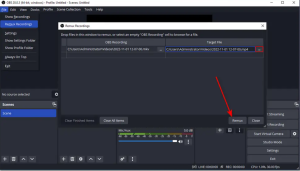Here is the recipe for Aloo Payaz kadhi video;
Here is a recipe for Pakora kadhi;
Source, Ingest, Prepare, Analyze and Consume
Here is the recipe for Aloo Payaz kadhi video;
Here is a recipe for Pakora kadhi;
There are two ways.
1> Activate Automatically remux to MP4 setting
Step 1. Open OBS and tap on File. Find the Settings and head to Advanced in the pop-up Settings window.
Step 2. Move to the Recording section and check the “Automatically remux to MP4” box.
Step 3. Hit OK to save the changes, and the auto MKV to MP4 is activated now!

2> Manually remux OBS MKV to MP4
Step 1. Run OBS and click File on the top menu bar, then select the Remux Recordings option.
Step 2. Add the MKV recording to the interface by clicking the three-dotted button under the OBS Recording section.
Step 3. Click the three-dotted button under the Target File to select an output path and rename the recording.
Step 4. Press Remux to start the process.

Reference
https://www.videoconverterfactory.com/tips/obs-mkv-to-mp4.html
It’s very simple. On windows 11, go to the root of project. Click on three horizontal dots and pick Options.

Click View under folder option and select “Show hidden files, folders, and drives”.

Remove all folder starts with .git or .vs.

The job is done.
To manage work, we need to create folders inside Branches. The key folders that can be created inside Branches are;
The main branch has to be in the root of repository. All working branches can be branch out from man into above folders;
Click on three vertical dots on main branch and create a working branch, feature/shahzad. You will see a folder and branch inside Branches. Very simple.
Here is the reference to article that will walk you through tf.exe and Git working for enforcing permissions;
The script below will list all the primary keys, that have at least one int or bigint in their columns with all other ask.
SET TRANSACTION ISOLATION LEVEL READ UNCOMMITTED
SELECT OBJECT_SCHEMA_NAME(p.object_id) AS [Schema]
, OBJECT_NAME(p.object_id) AS [Table]
, i.name AS [Index]
, p.partition_number
, p.rows AS [Row Count]
, i.type_desc AS [Index Type]
,K.increment_value as IncrementValue
,K.last_value as LastValue
,K.seed_value as SeedValue
,k.is_nullable
,k.is_identity
,k.is_filestream
,k.is_replicated
,k.is_not_for_replication
FROM sys.partitions p
INNER JOIN sys.indexes i
ON p.object_id = i.object_id
AND p.index_id = i.index_id
INNER JOIN SYS.TABLES S
ON S.object_id = P.object_id
LEFT OUTER JOIN sys.identity_columns K
ON P.object_id = K.object_id
WHERE 1=1
AND EXISTS ( SELECT 1
FROM SYS.COLUMNS C
INNER JOIN sys.types AS t
ON c.user_type_id=t.user_type_id
WHERE i.object_id = c.object_id
AND T.user_type_id IN (127,56) -- ONLY BIGINT AND INT
)
AND I.is_primary_key = 1
-- AND i.index_id < 2 -- GET ONLY THE CLUSTERED INDEXES - IF EXISTS ANY
-- get heaps too
--AND k.is_identity = 1 -- GET ONLY THE IDENTITY COLUMNS
ORDER BY [Schema], [Table], [Index]Reference